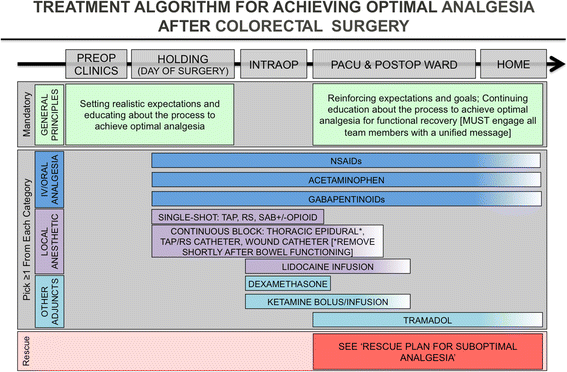American Society for Enhanced Recovery (ASER) and Perioperative Quality Initiative (POQI) Joint Consensus Statement on Optimal Analgesia within an Enhanced Recovery Pathway for Colorectal Surgery: Part 2-From PACU to the Transition Home
- PMID: 28413628
- PMCID: PMC5390469
- DOI: 10.1186/s13741-017-0063-6
American Society for Enhanced Recovery (ASER) and Perioperative Quality Initiative (POQI) Joint Consensus Statement on Optimal Analgesia within an Enhanced Recovery Pathway for Colorectal Surgery: Part 2-From PACU to the Transition Home
Erratum in
-
Correction to: American Society for Enhanced Recovery (ASER) and Perioperative Quality Initiative (POQI) Joint Consensus Statement on Optimal Analgesia within an Enhanced Recovery Pathway for Colorectal Surgery: Part 2-From PACU to the Transition Home.Perioper Med (Lond). 2018 Apr 10;7:4. doi: 10.1186/s13741-018-0086-7. eCollection 2018. Perioper Med (Lond). 2018. PMID: 29644050 Free PMC article.
Abstract
Background: Within an enhanced recovery pathway (ERP), the approach to treating pain should be multifaceted and the goal should be to deliver "optimal analgesia", which we define in this paper as a technique that optimizes patient comfort and facilitates functional recovery with the fewest medication side effects.
Methods: With input from a multidisciplinary, international group of experts and through a structured review of the literature and use of a modified Delphi method, we achieved consensus surrounding the topic of optimal analgesia in the perioperative period for colorectal surgery patients.
Discussion: As a part of the first Perioperative Quality Improvement (POQI) workgroup meeting, we sought to develop a consensus document describing a comprehensive, yet rational and practical, approach for developing an evidence-based plan for achieving optimal analgesia, specifically for a colorectal surgery within an ERP. The goal was twofold: (a) that application of this process would lead to improved patient outcomes and (b) that investigation of the questions raised would identify knowledge gaps to aid the direction for research into analgesia within ERPs in the years to come. This document details the evidence for a wide range of analgesic components, with particular focus on care in the post-anesthesia care unit, general care ward, and transition to home after discharge. The preoperative and operative consensus statement for analgesia was covered in Part 1 of this paper. The overall conclusion is that the combination of analgesic techniques employed in the perioperative period is not important as long as it is effective in delivering the goal of "optimal analgesia" as set forth in this document.
Keywords: Analgesia; Colorectal surgery; Enhanced recovery pathway; Multimodal; Non-opioid adjuncts; Optimal analgesia; Outcomes; Pain management; Post-discharge; Postoperative; Quality.
Figures


References
-
- Alawadi ZM, Leal I, Phatak UR, Flores-Gonzalez JR, Holihan JL, Karanjawala BE, Millas SG, Kao LS. Facilitators and barriers of implementing enhanced recovery in colorectal surgery at a safety net hospital: a provider and patient perspective. Surgery. 2016;159:700–12. doi: 10.1016/j.surg.2015.08.025. - DOI - PubMed
LinkOut - more resources
Full Text Sources
Other Literature Sources
Research Materials

